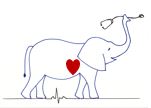ECG Quiz
1. What is the name of the highlighted section of the ECG and what does it represent?

a. QRS complex; ventricular depolarization
b. P wave; atrial depolarization
c. T wave; ventricular repolarization
d. S-T segment; resting membrane potential
Answer
2. Certain cell is the heart have the property of automaticity. Which of the following statements is most correct about automaticity?
a. The cells with the fastest automatic properties are found in the ventricular Purkinje fibers
b. Because of an extensive syncytium in the myocardium, all cells are considered to have automaticity, since if one fires they all fire
c. Cells in the sinus node have the slowest rate of automaticity
d. Cells with automaticity can generate their own impulse, without extrinsic stimulus, due to diastolic leak of potassium until threshold is reached
Answer
3. What is the likely explanation for the changes in the highlighted portion of this ECG?

a. Interference from solar flares
b. Artifact from electrical interference (60 cycle interference)
c. Paroxysmal atrial fibrillation
d. Paroxysmal sinus arrest
Answer
4. What cannot be accurately determined from an ECG of a horse?
a. Heart rhythm
b. Heart rate
c. The presence of ventricular enlargement
d. The duration of the P-R interval
Answer
5. The following ECG was obtained from a dog. What is your rhythm diagnosis?

a. Ventricular preexcitation syndrome
b. Ventricular fibrillation
c. Sustained ventricular tachycardia
d. Accelerated idioventricular rhythm
Answer
6. The following ECG was obtained from a cat with a urinary obstruction. What do you suspect is the cause and the likely rhythm diagnosis?

a. Sick sinus syndrome due to hypokalemia
b. Sinus arrest due to hypercalcemia
c. Atrial standstill due to hyperkalemia
d. Third degree AV block due to hypocalcemia
Answer
7. What ECG changes are expected in an animal with Second Degree AV Block?
a. Prolonged P-R interval
b. Some P waves without corresponding QRS-T
c. No relationship between P waves and QRS-T complexes
d. No P waves with atrial fibrillation waves and irregular ventricular response
Answer
8. What are the ECG findings on this ECG?

a. Sinus rhythm with right ventricular hypertrophy and ST segment elevation
b. Supraventricular tachycardia with electrical alternans
c. Sinus rhythm with left ventricular enlargement and ST segment depression
d. Ventricular tachycardia with left ventricular enlargement
Answer
